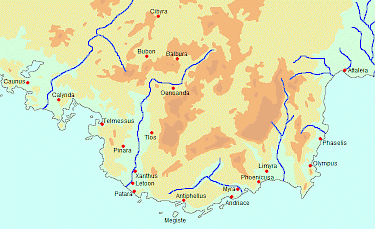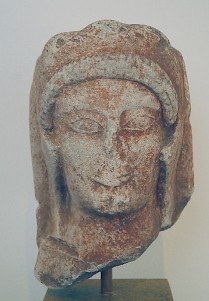Lycia (2)
Q18927Lycia: the mountainous southwest of Turkey.

The inhabitants of Lycia called themselves Trmmili, a name almost never used by other nations, who invariably called them Lycians. An exception is Herodotus, who correctly calls them "Termilae" and informs his reader, rather implausibly, that these people were renamed when an Athenian called Lycus had come to live with them.note
The Lycians become archaeologically "visible" in the eighth century BCE, when the acropolis of Xanthus was settled. Not much later, Greeks from Rhodes founded Phaselis and several other towns. These settlers must have given the alphabet to the Lycians, and their demand for agricultural products must have stimulated the economy. Yet, most people remained shepherds, roaming through the mountains with their herds. When, in the first half of the sixth century, the Lydian kings Alyattes (r. ca.600-ca.560) and Croesus (r. ca.560-ca.547) united western Turkey, Lycia remained independent - at least according to Herodotus.note It was impossible to send an army into the mountainous area, and besides, there was little to conquer in a country of pastoralists.

After 547, the Persian king Cyrus defeated Croesus and added the Lydian kingdom to his empire. After he had left, his general Harpagus led several mopping up operations, and he was the first to conquer the Lycians. According to Herodotus, his army completely destroyed Xanthus and killed all inhabitants, except for eighty families that had not been in town during the attack.note They may have been shepherds, who were in the mountains.
After the Persian conquest, the dynasty of Xanthus became more important, and it is almost certain that it owed its special position to Persia. It is likely that the great king had appointed the Xanthian prince as representative of all Lycians, responsible for the payment of tribute. (If we are to believe Herodotus' list of Persian satrapies, king Darius regarded the Pamphylians, Lycians, Carians, Ionians, Magnesians, Aeolians, and Milyans as one tax unit.note) The Xanthian was also the commander of the Lycian fleet. Herodotus mentions a man named Cybernis as taking part in Xerxes' invasion of Greece (in 480).note His real name must have been Kuprlli.
There were other dynasts. Names like Khinnakha, Sppntaza, and Tethtiweibi are known from inscriptions and coins, which were issued to pay soldiers and to stress the dynast's autonomy. (The economy was not yet monetized, so coins served other purposes.) Yet, the Xanthian dynasty was clearly the most powerful.